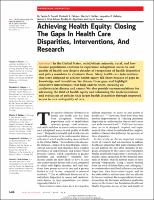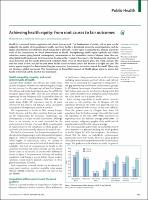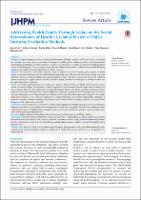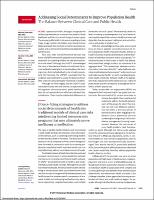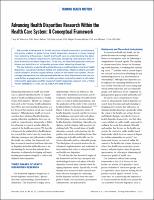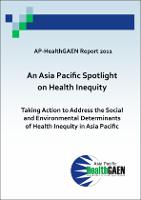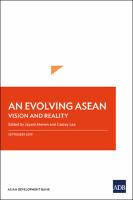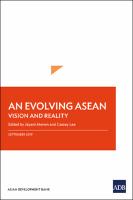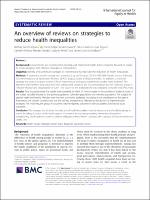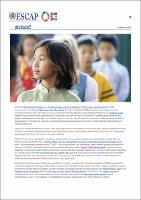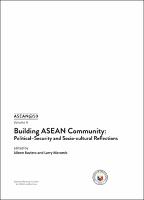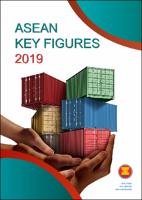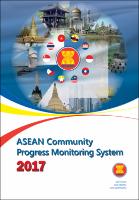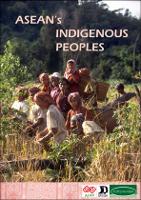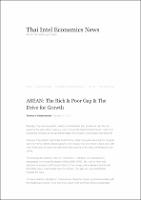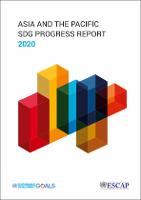Browsing by Title
Now showing items 13-32 of 229
-
Achieving Health Equity: Closing The Gaps In Health Care Disparities, Interventions, And Research
(2016)
In the United States, racial/ethnic minority, rural, and lowincome populations continue to experience suboptimal access to and quality of health care despite decades of recognition of health disparities and policy mandates to eliminate them. Many health care interventions that were designed to achieve health equity fall short because of gaps in knowledge and translation. We discuss these gaps and highlight innovative interventions that help address them, focusing on cardiovascular disease and cancer. We also provide recommendations for advancing ... -
Achieving health equity: from root causes to fair outcomes
(The Lancet, 2007) -
Addressing Health Equity Through Action on the Social Determinants of Health: A Global Review of Policy Outcome Evaluation Methods
(Kerman University of Medical Sciences, 2018-02-06)
Background: Epidemiological evidence on the social determinants of health inequity is well-advanced, but considerably less attention has been given to evaluating the impact of public policies addressing those social determinants. Methodological challenges to produce evidence on policy outcomes present a significant barrier to mobilising policy actions for health equities. This review aims to examine methodological approaches to policy evaluation of health equity outcomes and identify promising approaches for future research. Methods: We conducted ... -
Advancing Health Disparities Research Within the Health Care System: A Conceptual Framework
(American Journal of Public Health, 2006-12)
We provide a framework for health services–related researchers, practitioners, and policy makers to guide future health disparities research in areas ranging from detecting differences in health and health care to understanding the determinants that underlie disparities to ultimately designing interventions that reduce and eliminate these disparities. To do this, we identified potential selection biases and definitions of vulnerable groups when detecting disparities. The key factors to understanding disparities were multilevel determinants of ... -
An Asia Pacific Spotlight on Health Inequity: Taking Action to Address the Social and Environmental Determinants of Health Equity in Asia Pacific
(2011)
In the full report we describe the extent of health inequities between and within countries across the Asia Pacific region. We explore the plausible causal relationships between social and environmental factors and health inequities and describe actions that are taking place to improve health inequities in Asia Pacific. The report is based on pre-existing data policy-mapping case studies and expert knowledge from across the region. We have drawn upon reports and peer-reviewed publications from a diversity of disciplines such as public health ... -
An Evolving ASEAN: Vision and Reality
(Asian Development Bank, 2019)
The formation of ASEAN in 1967 was originally driven by political and security concerns. In the decades that followed, ASEAN’s scope evolved to include an ambitious and progressive economic agenda. In December 2015, the ASEAN Economic Community (AEC) was formally launched. Although AEC has enjoyed some notable successes, its vision of economic integration has yet to be fully realized. The publication reviews the evolution of ASEAN economic integration and assesses the major achievements. It also examines the challenges that have emerged during ... -
An evolving Asean: vision and reality
(Asian Development Bank, 2019-09)
This volume is a compilation of the papers presented at the High-Level Workshop on the Evolving Nature of ASEAN’s Economic Cooperation: Original Vision and Current Practice, containing the authors’ personal reflections on ASEAN’s journey toward economic integration. The papers review the historical evolution of ASEAN’s economic agenda, capture its achievements, examine the challenges that have surfaced in the last decade, and recommend a way forward. The papers in this volume emphasize that, while there have been notable successes, the remaining ... -
An overview of reviews on strategies to reduce health inequalities
(2020-12)
Background: Governments are incentivized to develop and implement health action programs focused on equity to ensure progress with effective strategies or interventions. Objective: Identify and synthesize strategies or interventions that facilitate the reduction of health inequalities. Methods: A systematic search strategy was carried out up until August 2019 in MEDLINE (Ovid), Embase (Elsevier), Cochrane Database of Systematic Reviews, LILACS, Scopus, Scielo and Epistemonikos. In addition, a snowball strategy was used. Literature reviews (LRs) ... -
Are we REALLY getting everyone into the picture?
(2021-03-26) -
ASEAN @50Volume 4: Building ASEAN Community: Political-Security and Socio-cultural Reflections
(ERIA, 2017)
ASEAN has gradually built, on the basis of both shared interests and common principles and norms, various practices and mechanisms that helped prevent conflict among its members and allowed it to play an autonomous role in shaping the regional security architecture. Overcoming the member states' preoccupation with their own national concerns to give way to advocacy of collective interests has remained difficult, but progress is being made. Part A of this volume looks at the processes and dynamics, challenges, and opportunities of ASEAN ... -
ASEAN Community Progress Monitoring System 2017
(The ASEAN Secretariat, 2017) -
ASEAN Economic Progress 1967-2017 (leaflet)
(The ASEAN Secretariat, 2017) -
ASEAN Key Figures 2019
(The ASEAN Secretariat, 2019) -
ASEAN Social Progress 1967-2017(Leaflet)
(The ASEAN Secretariat, 2017) -
ASEAN statistical report on millennium development goals 2017.
(The ASEAN Secretariat, 2017) -
ASEAN's Indigenous Peoples
(AIPP,IWGIA,FORUM-ASIA, 2010)
Indigenous Peoples are not at all mentioned or referred to in any ASEAN document, even though they are an integral part of the ASEAN Community and among its most vulnerable sectors, whose interest the ASEAN has committed itself to protect. The failure of the ASEAN to address the plight of its Indigenous Peoples despite its expressed commitment to human rights and social justice is a shortcoming that needs to be corrected urgently. Unless Indigenous Peoples are fully recognized as integral part of a culturally diverse ASEAN, and unless Indigenous ... -
ASEAN: The Rich & Poor Gap & The Drive for Growth
(2014-02-17) -
Asia and the Pacific SDG progress report 2020.
(United Nation, 2020)
This report analyses trends as well as data availability for monitoring progress toward the Sustainable Development Goals (SDGs) in Asia and the Pacific and its five subregions. It assesses gaps which must be closed to achieve the goals by 2030. This assessment is designed to ensure the region’s actions remain on target, shortcomings are addressed as they arise, and all interested parties remain engaged. It is an invaluable resource for all stakeholders involved in prioritization, planning, implementation and follow-up of the 2030 Agenda for ...

